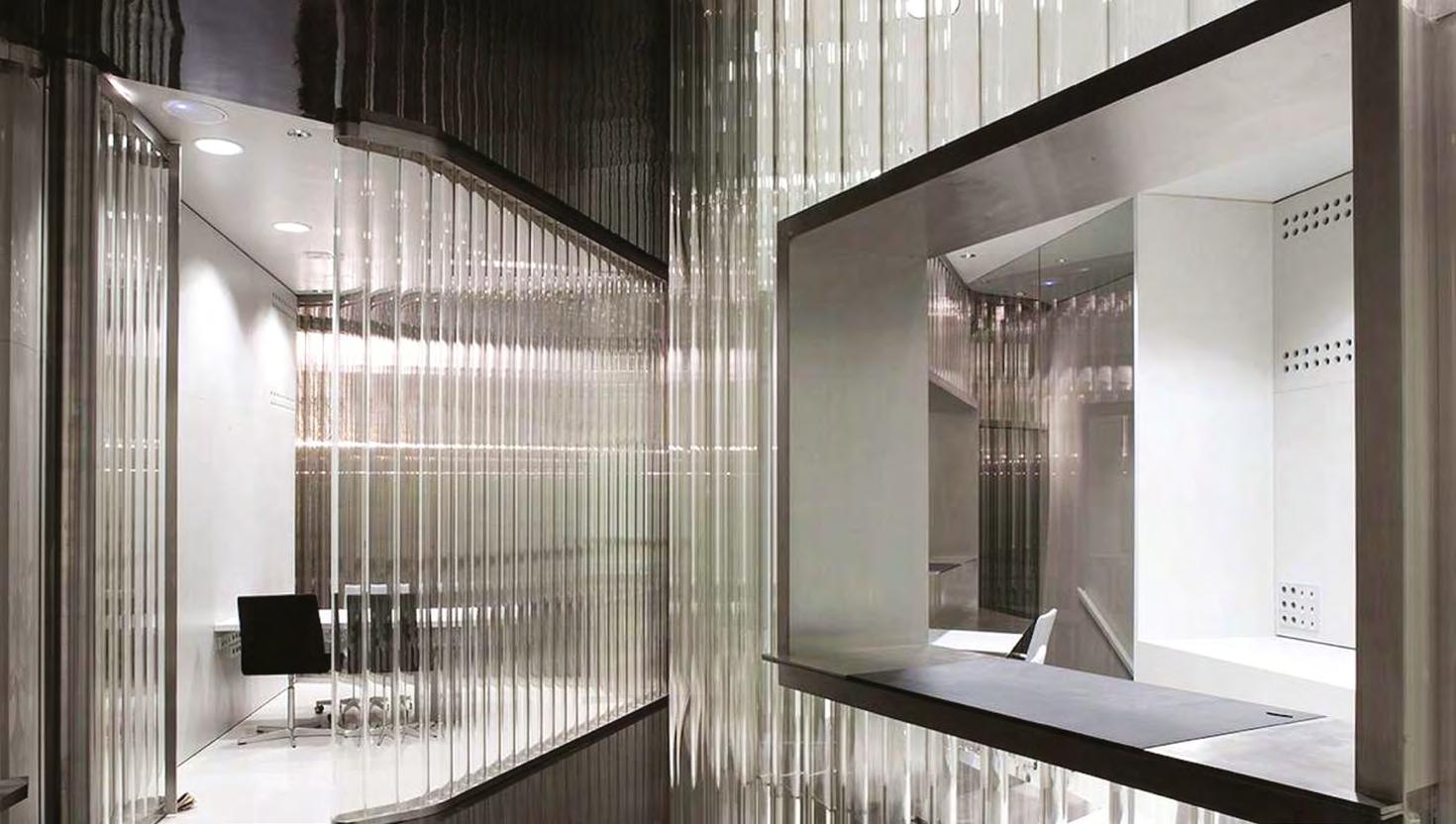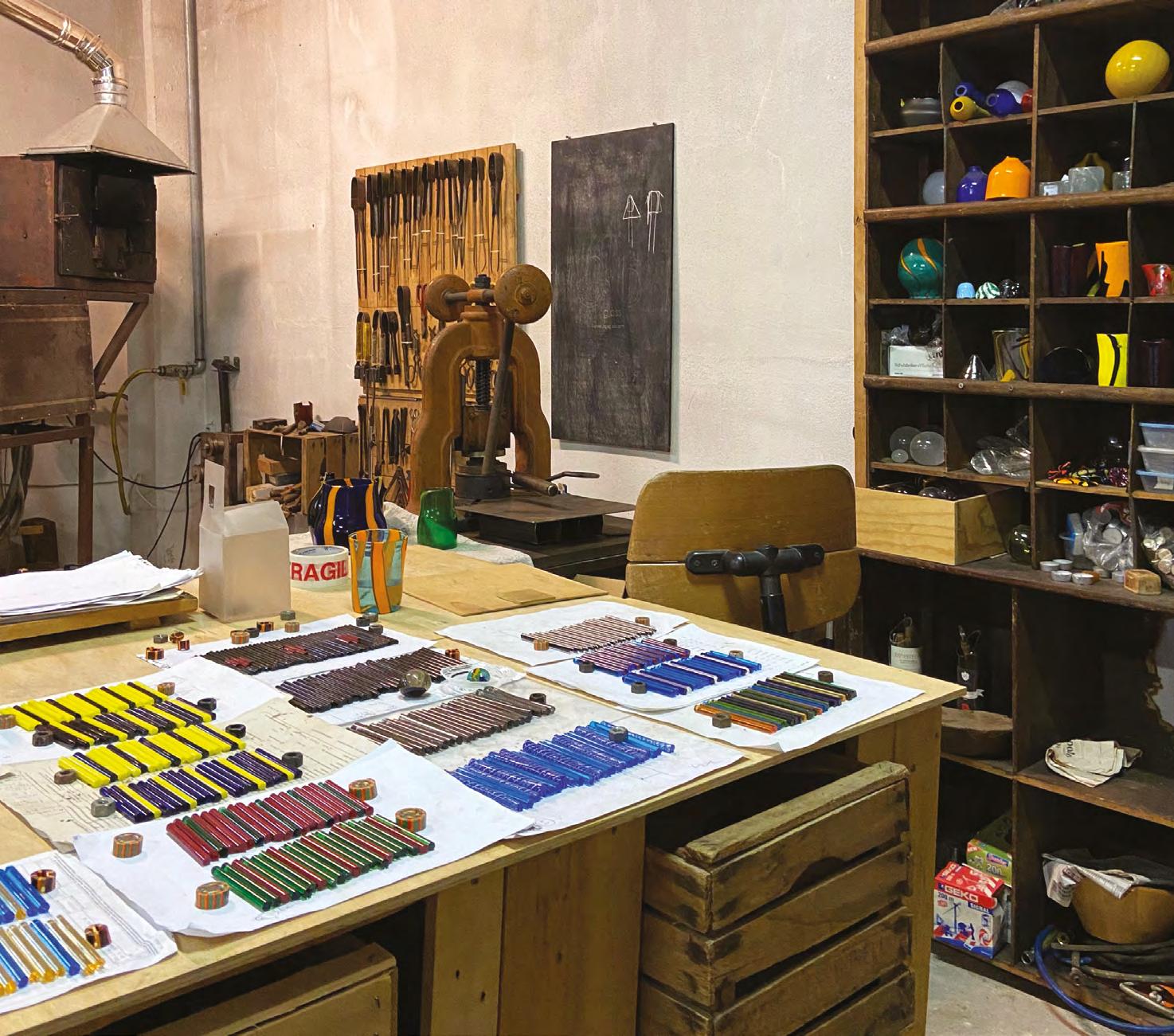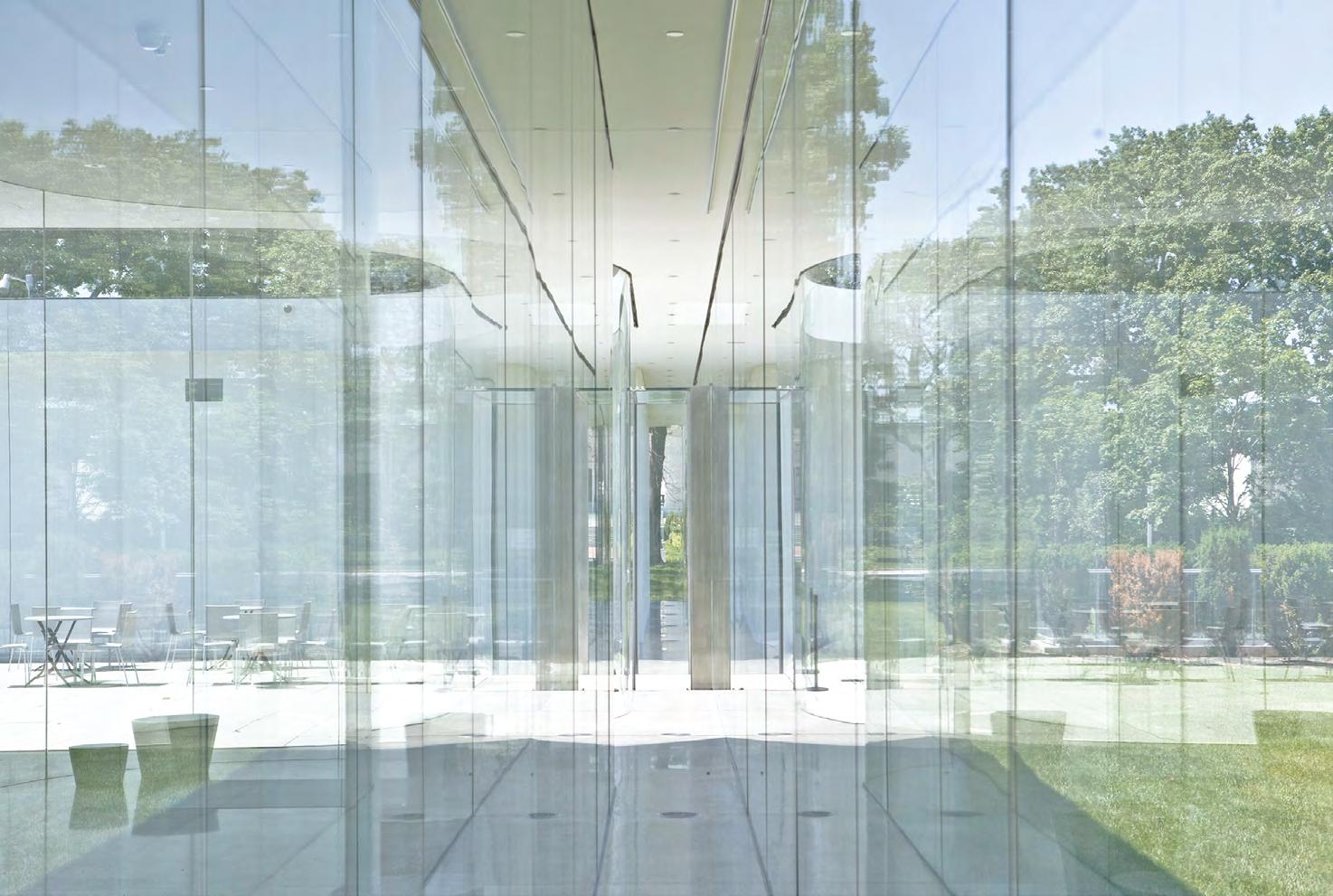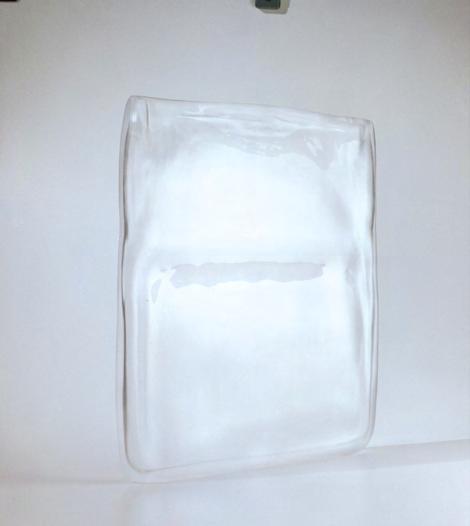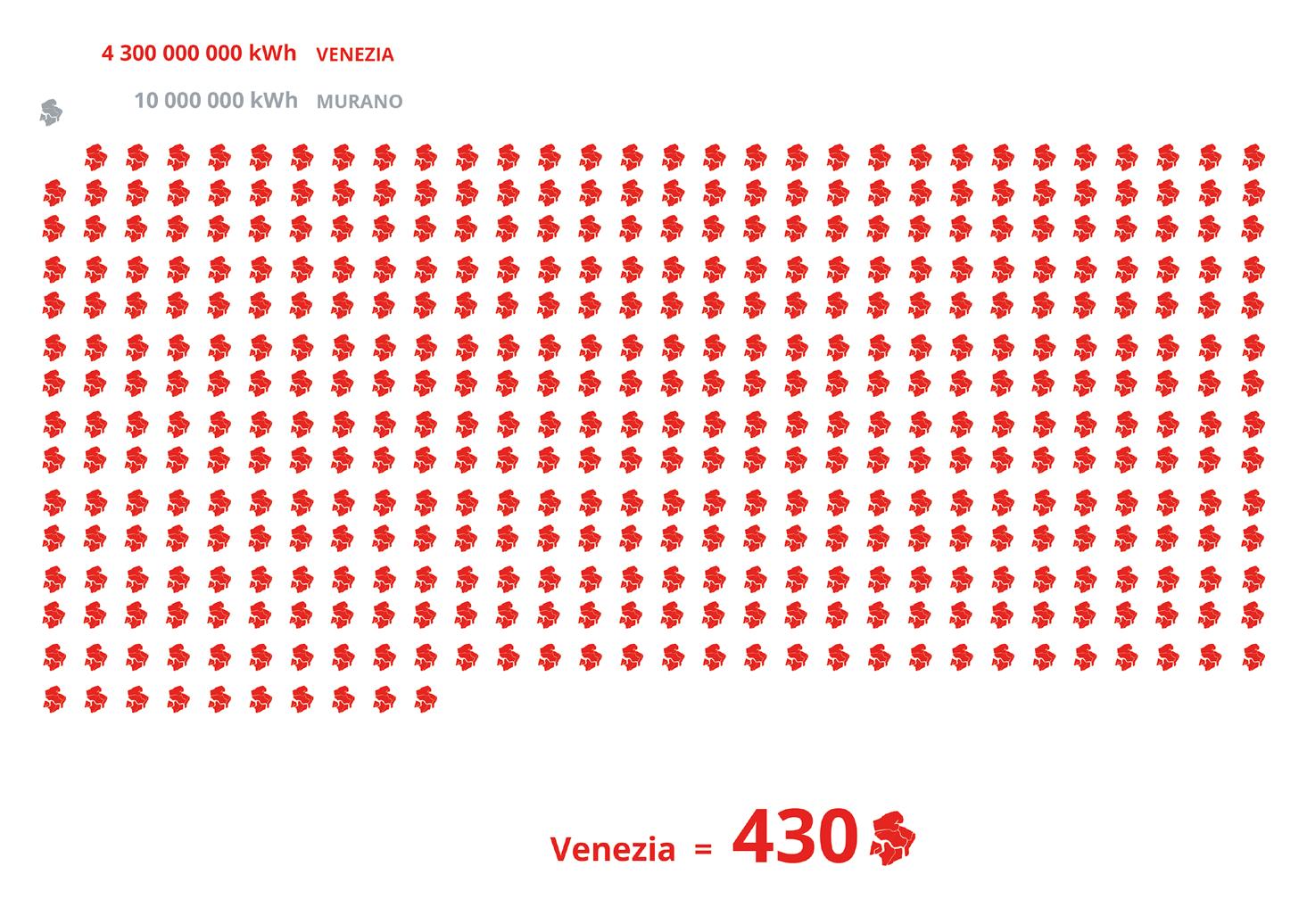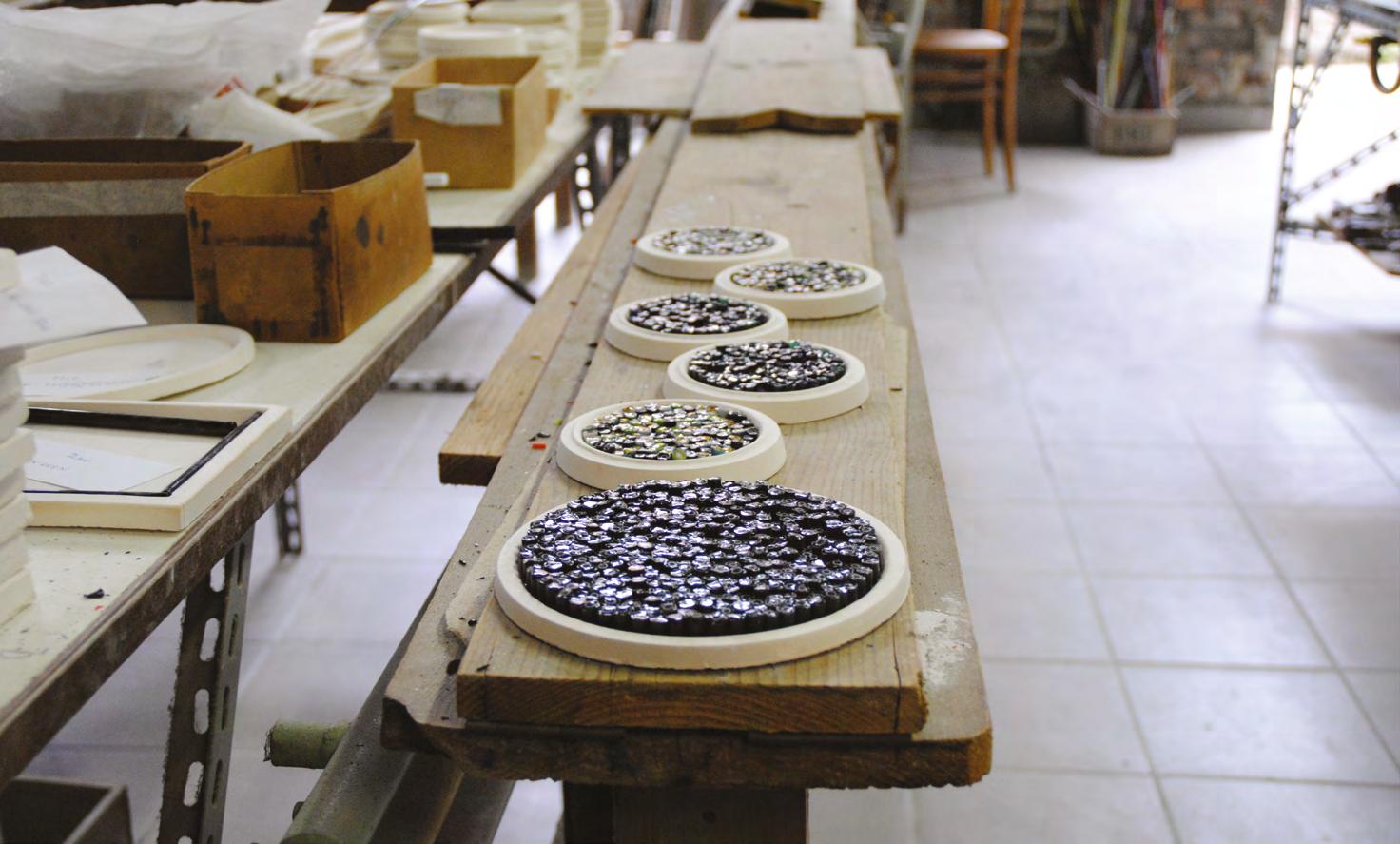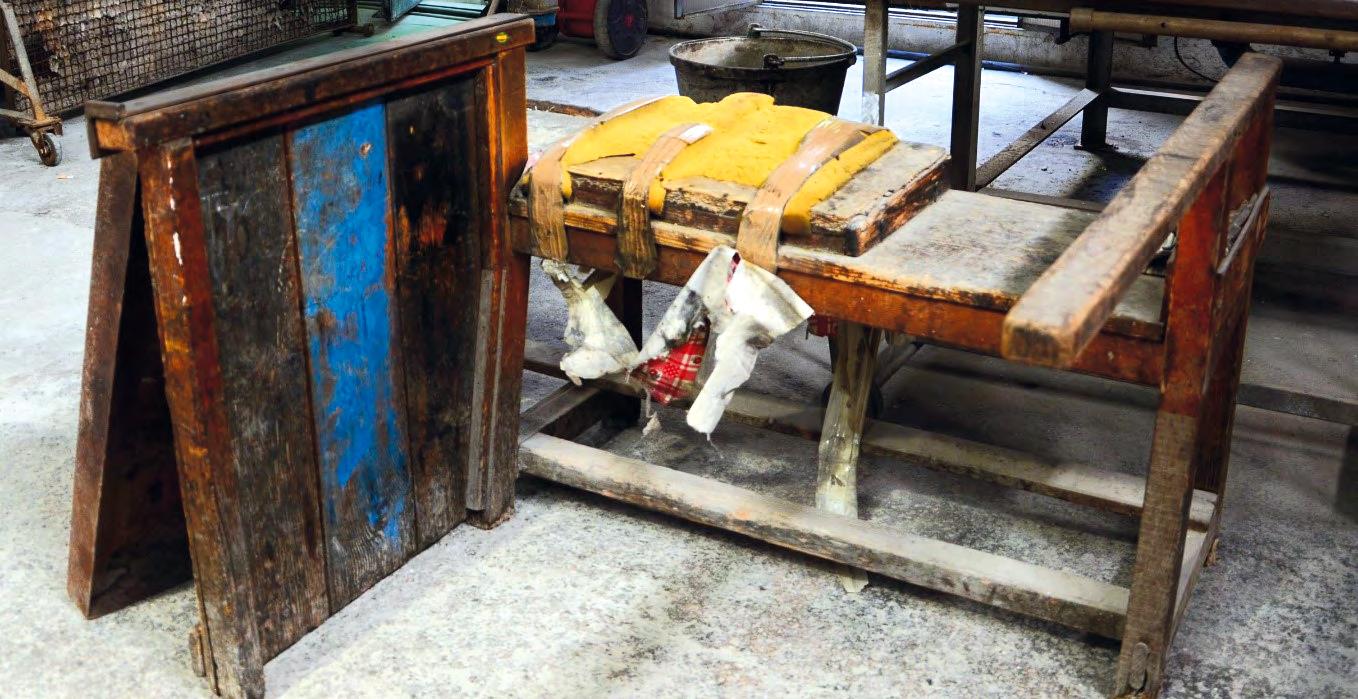
24 minute read
Glass and light. Suspension lamp design in Italy between 1930 and 1969 in the magazines
FEDERICA DAL FALCOA, RAISSA D’UFFIZIB
KEYWORDS: PENDANT LAMPS, MAGAZINE STUDIES, HISTORY OF DESIGN
Consistent with the theme of the antifragility of glass, understood as the material’s ability to cope with crises by developing innovations, the contribution proposes a reconstruction between the early 1930s and the mid-1960s of the evolution of a particular category of lighting fixtures: glass pendant lamps. The methodology adopted refers to evolutionary theses applied to families of objects, in which the “archetypes” are transformed while maintaining their matrix in the scenario contemporary to them. The research is carried out using the typological method aimed at modern design studies, through the perusal of some of the leading design and architecture magazines. The result is a jigsaw puzzle of types that, in addition to its documentary and aesthetic value, demonstrates its resilience by adapting, in a balance between tradition and innovation, to the transformations of different contexts in the sign of the mastery and elegance of glass design.
A Associate Professor in Design, PDTA Department, Sapienza University of Rome B PhD student, PDTA Department, Sapienza University of Rome
Material heritages: testimonial objects with civilisation value
In the last Century, glass products underwent a radical transformation due to the introduction of new glass materials, figurative registers and technologies in keeping with the languages of modernity. In this sector, historical events and wartime crises were the driving force behind complex innovations in both architectural elements and the most diverse types of objects. With an oxymoron, the characteristic fragility of glass is juxtaposed with its opposite meaning, understood as the material’s ability to be resilient and respond to change over time, anticipating new lifestyles. The contribution proposes a reconstruction of the evolution of the typology of hanging lamps made by the most important glass companies between the 1930s and the 1960s. The methodological reference is the studies inherent to archaeological sciences, which have clarified how cities, architecture, landscapes and objects have always been an expression of man’s knowledge in relation to a time and a place. In this sense, finds from the past are documents in which we can read our evolution related to social and anthropological aspects (Manacorda, 2004, 4).
This approach was extended to urban research and 20th Century architecture several decades ago, with less attention paid to the object systems of modernity. In contrast to buildings, things constitute a light and mobile stratification, they travel geographically and in time, transmitting signals from the past, but they must be considered as “material evidence with the value of civilization” (Atti Commissione Franceschini, 1967). Many objects disappear, become antiquated, only to be reborn upon their discovery. In this sense, design can be studied by analysing the development of categories of artefacts, according to evolutionary lines that identify birth, expansion, saturation, up to decay. It is a matter of classifying complex ramifications in which the “archetypes” maintain their matrix, while transforming themselves through technological experimentation and new languages that place them in their contemporary scenario (Branzi, 2007). In the history of decorative and industrial arts styles, a first step is to identify copying and inheritance: these are the gradual, sometimes involuntary transformations resulting from small changes introduced at each stage. Through experimentation, testing and the running behaviour of materials, a process of technological improvement takes place in which certain solutions tend to endure by becoming models (Steadman, 1979). The concept of evolution of objects was advanced in the early 1940s by Carlo Emilio Rava in the pages of Domus comparing antique and modern furniture in relation to their functionality, main components and rationality of assembly. These are representative examples of constant evolutionary lines, denoting the transition from antique to modern in relation to new materials and production processes.
What method and what tools can be used to classify the objects of modernity? In archaeology, associable types constitute what Gordon Childe called the Archaeological Record (Childe, 1956, p.9). These are “things” whose
characteristics originate renewable groups with reference to the “typological method” that Oscar Monteliussystematised in the second half of the 19th Century in relation to evolutionary theories (Manacorda, 2004, p. 59). This methodology, which identifies and classifies archaeological artefacts into groups, can be extended to the objects of modernity by ordering objects from one historical period with the same characteristics.
But how do you “dig” to reconstruct the evolution of pendant lamps? The investigation was conducted by perusing some of the most important magazines in the sector during the period in question (Domus, Casabella, Casa Novità, Ottagono, Lo Stile nella casa e nell’arredamento) and selecting specialised articles, advertising inserts, photographs and captions. The result is a typological repertoire of modernity, where the forms and workings of glass present elements of continuity linked to tradition and evolutionary leaps indicative of more radical innovations. These are forms of glass that reflect the taste and style of the different decades, according to a broad meaning of the term, well expressed by Giò Ponti, as the relationship between art and life and therefore the expression of a particular climate (Ponti, 1941, pp. 11-12). The picture that follows gives us fragments of modernity, which in addition to their documentary and aesthetic value, signal places, environments and interactions, lifestyles of the past, and are bearers of a heritage of memories that are not only material. The hanging lamp typology contributes to the narration of glass, understood as a resilient and innovative material, transformed into objects with poetic features by the mastery of designers and companies of excellence. Types of light that, because of their central location in the environment, illuminate stories and memories of people and families who, in the domestic habitat and beyond, have used them throughout their lives.
The 1930s and 1940s. Types between rationality and fantasy of precisions
The evolution of pendant lamps followed the emergence of Italian rationalist architecture from the early 1930s onwards, before moving towards freer and more organic solutions after the war. These objects are representative of Italian creativity that constitute the prodromes of Made in Italy and correspond to the three key concepts of design culture set out by Giò Ponti in his autobiography (Ponti, 1957, p. 81). The first is a praise of the fantasy of precision, which allows an artefact to be conceived in an exact manner so that the smallest detail corresponds to the whole. The second concerns colour, which must correspond to the chromatic qualities of the materials chosen, while the third reflection focuses on the test of time, that is, the importance of durability associated with the formal and material qualities of architecture and objects.
As is well known, since 1935 the Italian political context of the twenty-year fascist period, with the sanctions imposed by the League of Nations due to the
aggression against Ethiopia, was characterised by economic autarchy applied to all productive sectors. The exploitation of national and colonial raw materials was matched by experimentation with innovative materials, or substitutes as an alternative to the missing resources, with products for architecture, design and fashion (Dal Falco, 2014). And glass, derived from the processing of siliceous sands found in Italy, was considered among the “autarkic materials par excellence”. In fact, there were numerous innovations in the sector: safety crystals, translucent diffusers for glass-cement structures, glass fibres and opaline coatings, which with their lightness, transparency and luminosity asserted themselves as vectors of a new spatial concept (Dal Falco, 2017a, pp. 278-285).
In the lighting sector, the new types of lamps made of ground glass and crystal, paste worked, engraved, coupled with metals, constituted a relevant field of experimentation linked to those principles of modernity already affirmed since the early 1920s especially in France and in the Bauhaus first in Weimar and then in Dessau. In particular, in the category of pendant lamps, the selection made through the perusal of specialised journals can be ascribed to the following types: canopy lamps, globe lamps, arm lamps and lanterns. In general, the research on shapes is marked by essentiality, with a material mix that reflects the specificity of Italian design culture, straddling craftsmanship and industrial production.
The qualities of the glass, the parabolic or conical shapes of the reflectors, the translucent surfaces and indirect lights, the white, coloured etched or satinfinished sheets, the coupling with bronze or light alloy castings, are indications of a strong dynamism in the sector, with refined and innovative products. Already at the end of the 1920s, Carlo Clerici makes it clear how, referring to flame candelabra, artificial lighting is no longer a furniture item, but by integrating itself into the environment structures the space. Furthermore, the issue of lighting technology entails a renewal of the professional profile of the architect, whose role is likened to that of the director who operates considering different specialist skills (Clerici, 1928, pp. 44-46).
The aesthetic aspect of glass lamps, considered as objects that contribute to the harmony of the habitat, was the underlying theme of the 5th Milan Triennale of 1933. Examples of this are the “calotte” and “arm” type, such as the oval “laguna” glass lamp with rosy cup and golden leaves by Venini (Domus, 67, p. 381; Domus, 94, p. 18) and the ten-light chandelier in embossed crystal and copper parts (Domus, 67, p. 381) (Figure 1). Against these figurative themes, there was no lack of objects with rigorous lines of rationalist inspiration, with plays on geometry and light, such as the lamps by Franco Albini for Biancardi and Jordan “suitable for extremist environments, to tie in with the clarity of crystal and steel furniture” (Domus, 69, p. 500) (Figure 2).
Three years later, at the VI Triennale, ceiling lamps combined full geometric shapes with the minute and refined workmanship of crystal (Domus, 103, pp.
32-33) (Figure 3). A significant variant for the domestic environment is the upand-down type for the desk or with a rigid metal tige, which from the early 1930s was to be the subject of experiments on luminous efficiency (Domus, 78, p. 37) (Figures 4), with results of the highest level if the design is entrusted to Pietro Chiesa for Fontana Arte (Domus, 122, p. 25) (Figure 5) and at the end of the 1940s, when this typology will be considered a classic by its creator (Domus, 234, p. 35) (Figure 6). Or when it is Fontana Arte itself that innovates the genre with a cup in white lacquered crystal on the outside, inside which the lenses of the lower surface are ground transparent or mirrored (Domus, 158, p. 52) (Figure 7).
Another type is that of chandeliers with metal stems and bulbs. Such as the solutions designed by Professor Kalmar for Scaglia, in white metal with twentyfour flames and dome-shaped lampshades in frosted glass, or in brass in the shape of a sunburst. Guglielmo Ulrich’s lamps, also for Scaglia, consisted of thin brass or curved metal beams (Domus, 126, p. 52) (Figure 8), while Gino Sarfatti’s design reinterpreted this type with essentiality by using a simple curved ringshaped tube onto which lampholders and bulbs were grafted, all supported by electrical cords (Domus, 151, p. 89) (Figure 9).
Another genre is the “lanterna” chandelier, rational version of traditional shapes recalling mediaeval types, sometimes with oriental elements, always made with accurate plate treatments. There are numerous examples in the pages of Domus, from the more sophisticated types with ground and engraved crystal for Venini, (Domus, 135, p. 78) (Figure 10), to the shaped and groundplatesdesigned by Pietro Chiesa for Fontana Arte (Domus, 147, p. 52) (Figure 11). An example reflecting the integration of lighting body and architectural space is the large suspension in the atrium of the Rector’s Office of the University City of Rome. Composed of two spherical caps and an inverted truncated cone made of glass with alternating transparent and sandblasted stripes, the lantern was made by Fontana Arte at the invitation of Marcello Piacentini, who had already been appointed “General Director and Chief Architect” of the new university complex by Mussolini in 1932. Costing 9,000 lire, the lamp was probably designed by Pietro Chiesa, although there are no documents attesting to its authorship (Dal Falco, 2017b, 40) (Figure 12). Finally, the milk-white glass globes with and without aluminiumtige, for communal areas, corridors, toilets and bathrooms, helped to define the aesthetics of modernity, finding in design a free and light space for experimentation. In the following twenty years, the dome, globe and arm types would evolve with morphologies and workmanships more related to industry, while the lantern design would move towards decadence to be revived in the contemporary world with a different vision of their use.
The 1950s and 1960s. The synthesis of forms
In 1949, Pietro Chiesa died, Giò Ponti celebrated him in Domus in “L’opera di Pietro Chiesa” (1949) where he recalled his luminous artefacts for Fontana
Arte as an expression of “miraculous Italian quality” and an “excellence of execution never surpassed” (p. 34). The binomial between Pietro Chiesa and Fontana Arte seems to be the point of perfection in the production of glass pendant lamps between the 1930s and 1940s, where a constructive balance of glass is configured (Pagano, 1936, p. 10), through a “perfect taste and masterly experience” (Domus, 147, p. 52). Starting from the Second World War, during the years of reconstruction, “The new taste, the new needs, the new poetics of the interior first dreamed of and then demanded and aroused, in the vast and ductile range of its current possibilities, the glass technique” (Pica, 1949, p. 26). Considering Pietro Chiesa’s work as the forerunner of a modern taste (Domus, 252, p. 60), in the 1950s and 1960s, the design of glass pendant lamps developed into a phase of experimentation, in which forms were simplified through a synthesis procedure in line with industrial style. A break with tradition is evidenced through the exaltation of pure forms, the alteration of colours, the raw display of industrial elements, and the combination or replacement of glass with other materials such as metal or plastic.Through the perusal of trade journals, a number of recurring characteristics emerged which made it possible to categorize similar types of glass pendant lamps. The first recurring feature is the spherical shape, which includes, among the most emblematic examples, the LS1 model designed by Luigi Caccia Dominioni (Domus, 297, p. 26) (Figure 13) and the LS2 model designed by Ignazio Gardella (Domus, 313, p. 60) (Figure 14). Both products are characterised by a round glass shape, a clear reference to the circular image of the moon, the night light source par excellence. The sphere becomes the perfect form through which the purity of the volume is extreme, and the condition of absolute balance is manifested.In 1960, VicoMagistretti also designed the “Omega” pendant lamp for Artemide (Domus, 382, p. 51) (Figure 15), with a matt nickel-plated brass cable, opaline glass globe and frosted glass inner diffuser. The geometric form is “broken down, sectioned, intersected until the final shape is obtained”, resulting in a sphere section (Ottagono, 1, p. 55). Even Gino Sarfatti, a lamp designer since 1936 always in search of new forms and techniques for lighting (Rosselli, 1953, p. 59), collaborated with Arteluce to counter the classical tradition of “curly, neo-liberal chandeliers” (Casa Novità, 1, p. 23) (Figure 16). Sarfatti worked by reduction to obtain a spherical shape, “perfect, pure and with something magical”, creating “metal and crystal spheres, clusters of festive, Christmas and adjustable spheres, spherical joints [...] More than lamps, they were characters destined to give a physiognomy and a flavour to our homes, to transform the simple operation of turning the switch into a meeting with an old friend” (Baldini, 1961, p. 25). This type of hanging lamp determines that spatial balance in home interiors that Piero Della Francesca also reconstructed in the Pala di Brera (1472-1474), where an egg, uniformly lit, is the central point of space and symbol of life.
Canopy lamps are also a frequent type in which the circular shape is partially subtracted to create a modern profile. Franco Albini and Franca Helg designed
01
05 06
10 11 02 03 04
07
12 08 09
13 14
Fig. 01 Ten-light chandelier with ashlar crystal bowl and copper metal parts, Domus, 1933, 67, p. 381. Fig. 02 Chandelier designed by Franco Albini for Biancardi and Jordan, Domus, 1933, 69, p. 500. Fig. 03 Murano glass ceiling chandelier by Venini, Domus, 1936, 103, p. 33. Fig. 04 Pendant chandelier designed by Pietro Chiesa for Fontana, Domus, 1934, 78, p. 37. Fig. 05 Pendant lamp designed by Pietro Chiesa for Fontana Arte, Domus, 1938, 122,p. 25. Fig. 06 Reflected light chandelier with white lacquered metal cap and molta crystal disc, designed by Pietro Chiesa for Fontana Arte, Domus, 1949, 234, p. 35. Fig. 07 Chandelier with crystal bowl externally lacquered in white by Fontana Arte, Domus, 1941, 158,p. 52. Fig. 08 Lamps designed by Guglielmo Ulrich for Scaglia with bundle of brass stems, Domus, 1938, 126,p.52. Fig. 09 Chandelier by Gino Sarfatti for Artemide, Domus, 1940, 151, p. 89. Fig. 10 Shaped, ground and engraved rough crystal chandelier with metal frame, Domus, 1939, 135, p. 78. Fig. 11 Lantern-shaped metal-frame chandelier with six shaped and ground clear crystals, Domus, 1940, 147, p. 52. Fig. 12 The lantern in the Rectorate atrium. In La Città Universitaria di Roma, Architettura, special number, XIV, 1935. Fig. 13 Azucena ceilinglamp by Luigi Caccia Dominioni, Domus, 1954, 297, p. 26. Fig. 14 Lamp designed by Ignazio Gardella for Azucena, Domus, 1955, 313, p. 60.
15
19
22 16
20 17
21 18
23 24

Fig. 15 “Omega” pendant lamp by Vico Magistretti for Artemide, Domus, 1961, 382, p. 51. Fig. 16 Chandelier mod.2097 by Gino Sarfatti for Arteluce, Casa Novità, 1961, 1, p. 23. Fig. 17 Suspension lamp model “AM-AS” designed by Franco Albini and Franca Helg for Sirrah, Domus, 1969, 478,Advertising Sirrah. Fig. 18 “Black and White” lamp by Achille and Pier Giacomo Castiglioni for Flos, photograph by Giorgio Casali, Domus, 1965, 426, p. 31. Fig. 19 Glass pendant lamps designed by LiisiMeronen Beckmann and produced by the Vistosi glassworks in Murano, Domus, 1966, 435, p. 38. Fig. 20 Suspension lamp by Lumenform with white glass inner envelope and grey or light blue transparent glass outer envelope, Domus, 1964, 411, p. d/195. Fig. 21 “Tau” model lamp by Sergio Mazza for Artemide in matt nickel-plated brass, aluminium reflector and crystal bowl, Domus, 1963, 399, p. d/108. Fig. 22 White translucent glass pendant lamp by Martinelli, Domus, 1963, 403,p. d/141. Fig. 23 Suspension lamp by O-Luce consisting of two frosted glass bowls joined by a polished brass ring, Domus, 1963, 409, p. d/180. Fig. 24 Lampsproduced by Venini in collaboration with Massimo Vignelli, Domus, 1956, 316, Rassegna Domus.
the “AM/AS” model for Sirrah (Domus, 478) (Figure 17) which featured the opaline glass sphere in its semi-circular version. Achille and Pier Giacomo Castiglioni, who were often involved in the design of lighting fixtures, produced the “Black and White” pendant lamp for the company Flos around 1965, a product that allowed the light to be directed from concentrated to diffused (Domus, 426, pp. 29-33) (Figure 18); the shape of the fixture derives from the superimposition of two cups, the first in smaller aluminium, which reflects the light, and the second in opaline glass, which emits the light instead (Ottagono, 1, pp. 77). The glass pendant lamps designed by LiisiMeronen Beckmann and produced by the Vistosi glassworks in Murano (Figure 19) are also of interesting plasticity. They each consist of two glass shapes, one transparent inserted in the other coloured, which generate a play of transparencies (Domus, 435, p. 38). Or the pendant lamp by Lumenform (Figure 20) which has an upside-down white glass dome as its central core, covered by a rectangular volume in grey or light blue transparent glass which allows a glimpse of the inner dome, with a white inner envelope and outer covering (Domus, 411, p. d/195).
Sometimes the dome evolves through more blunted appearances and elements removed from the original spherical shape, as in the case of the “Tau” model designed by Sergio Mazza for Artemide (Figure 21) in matt nickel-plated brass, with a dark brown aluminium reflector and crystal bowl. The name, in assonance with the subtracted form of the Greek tau that characterises its lines, refers to that symmetrical and circular balance typical of pendant lamps (Domus, 399, p. d/108). In the case of Martinelli’s white translucent glass pendant lamp (Figure 22) the bevelled cap conceals the internal components through the opacity of the glass (Domus, 403, p. d/141) highlighting a “constant search for the application of evolved technical solutions, combined with the study of geometric forms” (Martinelli, 2018, p. 52). While in O-Luce’s pendant lamp (Figure 23), the two frosted glass cups are joined by a polished brass ring (Domus, 409, p. d/180).
A third typology identified is that of the organic and changeable form. Massimo Vignelli in collaboration with Venini produced a series of pendant lamps in a variety of shapes and colours including sapphire red, sulphur, tea powder, green, white, sky blue and pink (Figure 24). These pendant lamps, produced in Murano with simple shapes but all different and distinctive, are outlined with soft, sinuous curved lines, creating an unusual visual vibration (Domus, 316). Like Vignelli for Venini, the experimentation of architects and designers is manifested in their collaboration with companies, through the design of signature pendant lamps; there are many personalities who associate their signature with recurring production realities, as in the case of Gaetano Sciolari for Stilnovo, Flavio Poli for SegusoVetrid’Arte, Tito Agnoli for O-Luce, and Alessandro Pianon for Vistosi. Drawing a general picture, in the 1950s, historical companies rooted in the Murano reality, such as Seguso (1397), Salviati (1859), Borovier&Toso (1880), Vistosi (1945) continued their activity producing more traditional artefacts that were less suitable for industrial production.
On the contrary, alongside the products of Fontana Arte (1932) and Arteluce (1939), more modern realities such as O-Luce (1945), Stilnovo (1946), Mazzega (1946), Azucena (1947) and Martinelli (1950), Artemide (1959), Flos (1962) and LumenForm (1961), Sirrah (1968) were born with the reconstruction.
Towards contamination with new plastics
The glass pendant lamp, in the new industrial product culture, gradually abandoned its ornamental and classical nature, declaring itself on the contrary a humble, punctual and essential element in the modern space. In this period, artefacts simplified in form, clearly moving away from a lavish style and towards a more rational taste. Companies in the lighting sector produced numerous models of lamps, each of which, however, came in different types (pendant, table, floor and wall lamps) in order to offer similar solutions in the same environment and facilitate the stylistic homogenization of the modern home, a process which was widespread in this period.
The most significant innovation of these years, however, lies in a gradual but essential change in the history of glass pendant lamps. Glass, which had always been the preferred material in the design of these lighting fixtures, was progressively replaced in the production of lamps by other materials such as plastic or aluminium; these materials were less expensive, and more suitable for industrial and multiple production, and more prone to experimentation with new forms.
In particular, plastic materials make it possible to equal properties very close to those of glass such as transparency or colour variations or light transmission quality, and to solve more problematic aspects such as fragility, durability or heaviness. Glass therefore becomes plexiglass in the “Alvise” hanging lamp designed by Luigi Massoni for D. H. Guzzini (Domus, 453, p. d/392), or in methacrylate as in the case of the spherical pendant lamp designed for Kartell by the architect Luigi Bandini Buti (Domus, 456, p. d/401) and renews its anatomical structure, generating new abstract forms, as in the lamps “Taraxacum” and “Viscontea” by the Castiglioni brothers in coccon for Flos (Domus, 411, p. d/193).
The future of new materials and the fruitful experimentation in the design of pendant lamps undoubtedly opened up new scenarios for the lighting industry, which went from being mostly exclusively characterised by glass production, to being continued with new materials, where the glass element only exists to a small extent. From the 1960s onwards, glass seemed to become a material for elitist production, circumscribing its use mostly in handicrafts and more traditional forms. Gradually, glass production was limited to the Venetian lagoon, and products from the Murano glassworks became increasingly exclusive, sought-after and high-priced; the manufacture of pendant lighting fixtures was thus updated over time, first through a formal innovation of synthesis, and then through the use of materials other than glass. More generally, the narrative
of glass pendant lamps as a specific furniture product was always rather fragmentary and unspecific between the 1950s and 1960s. The descriptive space dedicated within design magazines can in fact be grouped into two types of narrative. The first is that which sees the product inserted within a setting, in which an in-depth analysis of the lamp rarely appears, except to provide the name of the manufacturer. The second case, on the other hand, proposes the product within reviews dedicated to lighting, with brief descriptions of the object (name of the company, the architects or designers who conceived the project, materials used, year of production and costs), which are too concise to trace an exhaustive history of glass pendant lamps.
The research managed to highlight certain formal specificities and trace changing trends over time with respect to characters, forms and materials. Glass was the preferred material in the design of pendant lamps between the 1930s and 1940s; experimented with in its countless formal and aesthetic possibilities in the 1950s, and joined in production, or perhaps overtaken, by new materials in the 1960s. We can say, that glass has undertaken an articulated but rather circular path, from the appropriation of Murano techniques outside its geographical area of origin, to the exclusive reintegration of history into its native boundaries: the design of glass pendant lamps has migrated outside its original borders, to finally return to the places of its tradition.
References
Atti Commissione Franceschini (1967). Atti Commissione Franceschini, relativa ai beni immobili e loro pertinenzecomprensive dell’arredamento (online). In http://www.icar.beniculturali.it/biblio/pdf/Studi/franceschini.pdf (last accessed August 2022). Baldini, R. (1961). I personaggi di Sarfatti. Casa Novità, 1, pp. 21-25. Branzi, A. (ed.) (2007). Capire il design. Firenze: Giunti editore. Casa Novità, 1, (1961). I personaggi di Sarfatti, pp. 21-25. Childe, V. G. (1956). A Short Introduction to Archeology. London: Collier Books. Clerici, C. (1928). Architetture moderne e illuminazione. Domus, 5, pp. 32-33. Dal Falco, F. (2014). Prodotti autarchici. 1930-1945. Architettura, design, moda. Studi sulla cultura del progetto per la tutela dei beni culturali. Roma: Rdesignpress. Dal Falco, F. (2017a). Vetro. Prodotto e applicazioni. Autori e opere. In L. Cupelloni (Ed.), Materiali del Moderno. Campo, tempi e modi del progetto di riqualificazione, pp. 278-285. Roma: Gangemi editore. Dal Falco, F. (2017b). Il Design della Città universitaria di Roma paradigma del progetto integrale della modernità italiana, Palladio, pp. 35-44. Domus, 67, (1933). I vetri d’arte italiana alla Triennale, pp. 380-381. Domus, 69, (1933). L’arte moderna nel vetro e nella illuminazione, p. 500. Domus, 78, (1934). Due nuove lampade ideate da Pietro Chiesa, p. 37. Domus, 94, (1935). Caratteri di alcuni arredamenti, p.18. Domus, 103, (1936). Venini-Murano. Tre lampadari a soffitto in cristallo variamente lavorato, pp. 32-33. Domus, 122, (1938). Non arredare, ma “circondarci” di quanto ci occorre e ci piace, pp. 24-25. Domus, 126, (1938). La luce nella casa, pp. 126, 52. Domus, 135, (1939). Documenti delle produzioni italiane. Cinque lampade, p. 78. Domus, 147, (1940). Il prodotto italiano deve essere indice di alta qualità, p. 52.
Domus, 151, (1940). Una serie ingegnosa e pratica di apparecchi di illuminazione, pp. 88-89. Domus, 158, (1941). Nella vostra casa abbiate l’orgoglio di avere prodotti italiani, p. 52. Domus, 234, (1949). I classici di Pietro Chiesa, p. 35. Domus, 252, (1950). Rassegna. Le lampade, p. 60. Domus, 297, (1954). A Napoli. Roberto Mango architetto, p. 26. Domus, 313, (1955). Tre versioni di una lampada, p. 60. Domus, 316, (1956). Rassegna Domus. Domus, 382, (1961). Due nuove lampade. Vico Magistretti architetto, p. 51. Domus, 399, (1963). Domus per chi deve scegliere lampade di serie. Produzione Studio Artemide, p. d/108. Domus, 403, (1963). Domus per chi deve scegliere lampade di serie. Produzione Martinelli Luce, p. d/141 Domus, 409, (1963). Domus per chi deve scegliere lampade di serie. Lampade Produzione O-Luce, p. d/180. Domus, 411, (1964). Domus per chi deve scegliere lampade in serie. Lampade produzione Flos, p. d/193. Domus, 411, (1964). Domus per chi deve scegliere lampade in serie. Lampade produzione Lumenform, p. d/195. Domus, 426, (1965). La casa abitata. Achille e Pier Giacomo Castiglioni: stanza da pranzo, pp. 29-33. Domus, 435, (1966). Lampade, p. 38. Domus, 453, (1967).Domus per chi deve scegliere lampade in serie. Lampade in plexiglas, produzione D. H. Guzzini, p. d/392. Domus, 456, (1967). Domus per chi deve scegliere lampade diverse. Lampade produzione Kartell, p. d/401. Manacorda, D. (2004). Prima lezione di archeologia. Roma-Bari: Laterza editore. Martinelli, E. (2018). Funzione ed estetica. Le prime lampade di Elio Martinelli. In Martinelli, E. (ed.), Elio Martinelli e la luce. Milano: Electa. Ottagono, 1, (1966). Coerenza nel design di Vico Magistretti, p. 55. Ottagono, 1, (1966). Lampada a due luci, pp. 70-77. Pagano, G. (1936). Un famoso binomio. Pietro Chiesa: la vetrina di Fontana Arte alla Triennale. Domus, 104, p. 10. Pica, A. (1949). Il cristallo nell’arredamento. Domus, 238, pp. 26-29. Ponti, G. (1941). Lo Stile nella casa e nell’arredamento, 1, pp. 11-12. Ponti, G. (1949). L’opera di Pietro Chiesa. Domus, 234, pp. 32-49. Ponti, G. (1957). Amate l’architettura. Genova: Società editrice Vitali e Ghianda. Rava, C. E. (1942). Funzionale antico e nuovo VII. Domus, 179, pp. 480-482. Rava, C. E. (1943). Funzionale antico e nuovo VIII. Domus, 185, pp. 220-222. Rosselli, A. (1953). Nuove lampade Arteluce. Disegno per l’industria. Domus, 289, pp. 59-61. Steadman, P. (1979). The evolution of designs. Cambridge: Cambridge University Press.

